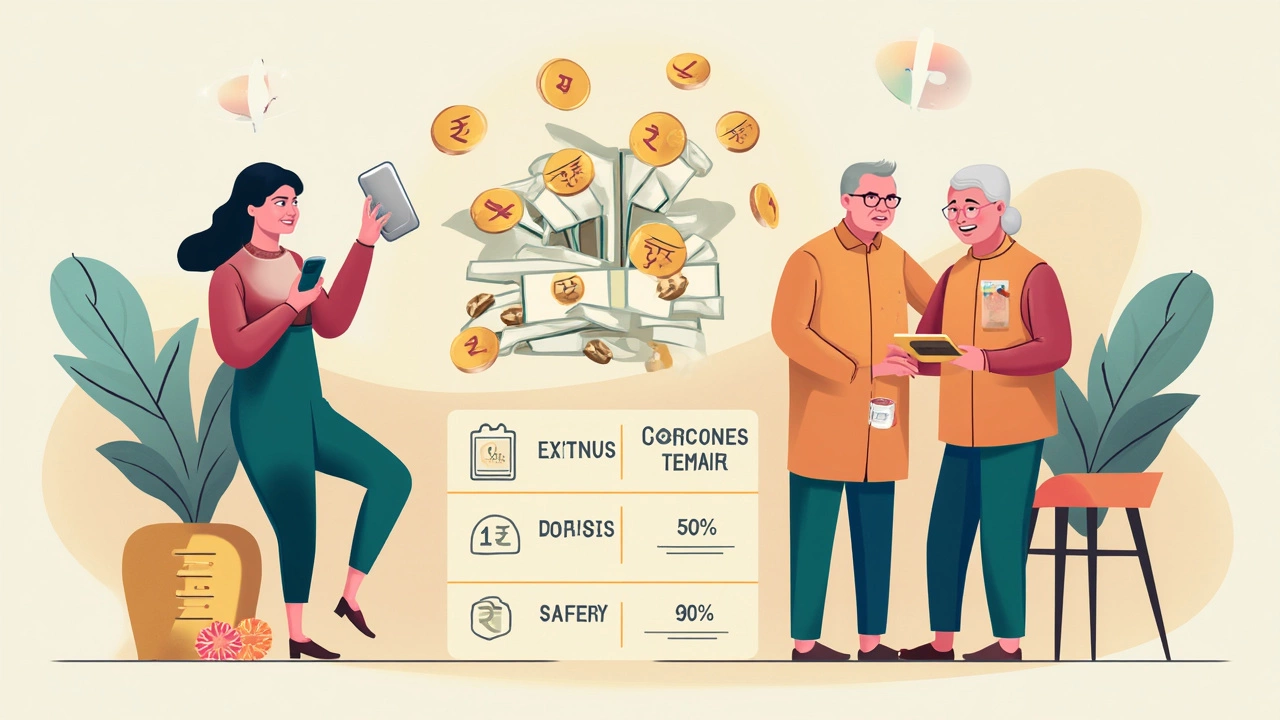
Stuffing your hard-earned cash into just any old savings account won’t cut it anymore. These days, banks love to pitch their latest “high interest” offers, but a lot hide fees or conditions in the fine print. Some accounts give you good rates only for a few months, then quietly drop down to almost nothing. It’s easy to get stuck with less than you deserve.
If you want your savings to grow and actually work for you, it pays to know your options. Not all savings accounts are created equal. Some boost your money with better rates, while others just give you easy access on the go. It comes down to your goals—are you saving for a new phone, a house down payment, or just a rainy day? The right account makes a huge difference in how fast your money adds up and how easily you can grab it when you need it.
Let’s break down the basics so you don’t leave any cash on the table. Picking the best place to stash your savings isn’t about luck. It’s about knowing what’s out there, paying attention to the details, and making banks compete for you, not the other way around.
- Why Not All Savings Accounts Are Equal
- High-Yield Savings vs. Fixed Deposits
- What to Watch For: Fees, Safety, and Access
- Making Your Money Work: Pro Tips for Savers
Why Not All Savings Accounts Are Equal
When it comes to choosing the best savings accounts, they might all look the same at first. But hidden differences can cost you real money. Banks use all kinds of tactics to stand out—some good, some designed to catch you off guard. Let’s be real: the interest rate you see upfront isn't always what you get over time.
Take interest rates for example. As of April 2025, top high-yield savings accounts from online banks in India are offering between 6% and 7.25% per year. Some digital wallets even push special promo rates for a couple of months, but then drop you back to a boring 3.5%. Traditional banks? Often lower, sometimes 3–5%, unless you lock your cash in for years.
The catch? Some banks want you to maintain a minimum balance. If you dip under, they hit you with fees that nibble away at your gains. Here’s a snapshot comparing a few types you’ll see around:
| Account Type | Avg. Interest Rate (2025) | Min. Balance | Access/Ease |
|---|---|---|---|
| High-Yield Savings (Online) | 6% – 7.25% | Rs. 0 – 10,000 | 24/7, App/Online |
| Fixed Deposit | 6.5% – 7.5% | Rs. 5,000 | Locked for term |
| Traditional Bank Savings | 3% – 5% | Rs. 5,000 – 20,000 | Branch/ATM |
| Digital Wallet Savings | 3.5% – 7% | None | App easy, not always insurable |
This is why reading the terms matters. Look for accounts with:
- No or low minimum balance
- Consistently good interest rates, not just teaser promos
- Easy access when you actually need your cash
- Automatic savings options (helps if you forget to move money yourself)
Watch out for sneaky monthly charges, limits on withdrawals, or reduced rates if you don’t meet certain ‘criteria’ each month. One time, Aditi and I thought we scored with a flashy 7% account—till we missed the fine print: you needed Rs. 50,000 sitting there at all times! Ouch.
So, not all savings accounts play fair—and you shouldn’t settle for less than your money should earn. Choosing wisely sets you up for faster, stress-free saving.
High-Yield Savings vs. Fixed Deposits
Choosing between a high-yield savings account and a fixed deposit isn’t just about chasing the highest interest rate. It’s more about how you want to use your money and how much flexibility you need. Here’s what actually matters.
High-yield savings accounts are designed for easy access. These accounts pay higher interest than regular savings, sometimes 3-4 times more. You can move your money in and out whenever you want, no questions asked. For folks who need their cash handy — say for surprise car repairs — this type of account is a solid pick. Just make sure you’re checking if that high rate sticks around after any promotional period. In India, for example, the best high-yield accounts as of April 2025 are offering between 4% and 6% annual interest, though the top deals tend to tie the highest rates to higher minimum balances or digital-only banking.
Fixed deposits — or FDs, as everyone calls them — are the old reliable. You lock away your money for a fixed time, usually from a few months to five years, and the bank pays you a guaranteed rate. The catch? You can’t touch those funds without a penalty. FDs are perfect if you know you won’t need the money soon and want to ignore the rate changes. In April 2025, most major banks in India are paying between 6.5% and 7.5% for one to two-year FDs, with smaller banks even breaking 8% sometimes. It’s simple, no hidden fees, no surprises.
| Account Type | Interest Rate (2025) | Access to Funds |
|---|---|---|
| High-Yield Savings | 4% – 6% | Anytime |
| Fixed Deposit | 6.5% – 8% | Locked (Penalty for early withdrawal) |
So, which is better? If flexibility matters and you want to dip in and out, a high-yield savings account takes the win. Saving up for a big goal and sure you won’t need the cash? FDs almost always pay a little extra, no hidden catches. It comes down to your own lifestyle—if Aditi and I were saving for a trip next year, we’d probably split our savings, putting half in an FD for the bonus interest and keeping the rest in a high-yield savings account for emergencies.
One more practical tip: Double-check if your bank is insured by the Deposit Insurance and Credit Guarantee Corporation (DICGC)—this covers both high-yield accounts and FDs up to ₹5 lakh per person, per bank. That’s real peace of mind, no matter where you stash your savings.

What to Watch For: Fees, Safety, and Access
So you've found a few options for your best savings accounts, but a sweet headline rate is only half the story. Banks and apps love to lure you in with promos, but dig deeper—it’s the hidden stuff that matters. Let’s break down what actually makes one account better than another.
Fees are the sneaky killer. Loads of high-yield savings accounts slap on monthly maintenance fees, low balance charges, or withdrawal penalties. Some even add tiny transfer fees. It’s a shame how fast those eat into your interest. Seriously, if your bank takes ₹250 every month just for holding your cash, your ‘savings’ won’t go far. Always read the fine print for:
- Monthly account maintenance charges
- Minimum balance requirements
- ATM withdrawal or transfer fees
- Penalty for early withdrawals (especially with fixed deposits)
Next, always check the account’s safety. In India, bank deposits are insured by DICGC up to ₹5 lakh per bank. That means, if a scheduled bank collapses, you’ll get up to five lakhs back—no matter how much you had. Private and public banks follow this rule. But, some fintech wallets or small NBFCs (Non-Banking Finance Companies) don’t offer this. That’s a huge risk if you plan to save big amounts.
Access is a biggie too. Ask yourself: How fast can I get my money out if there’s an emergency? With most online high-yield savings accounts, you get easy transfers via apps, IMPS, or even UPI—often 24/7. On the flip side, fixed deposits lock your money in. You can break them, but there’s usually a penalty and you’ll lose some interest. Some digital banks now even let you ‘break’ FDs instantly, but traditional banks can take a day or two.
| Bank | Interest Rate | Monthly Fee | Insurance (DICGC) | Instant Access? |
|---|---|---|---|---|
| SBI Savings Account | 2.7% | None (basic account) | Yes | Yes |
| HDFC High-Yield Savings | 4.5% | ₹200 (if below min. balance) | Yes | Yes |
| Digital NBFC Wallet | Up to 6% | Varies | No | Yes |
| ICICI Fixed Deposit | 5% - 7% | None | Yes | No (withdrawal penalty) |
Bottom line: go for zero fees, solid safety (DICGC coverage or better), and hassle-free access whenever you can. If a bank or app can’t tick all those boxes, keep hunting. Don’t settle just for a jazzy rate—you want your money protected and available when you need it most.
Making Your Money Work: Pro Tips for Savers
If you want your savings to do more than just sit in the bank, you need a game plan. Here’s how regular people like us make every rupee count.
- Compare interest rates—every six months. Banks switch up their best savings accounts offers often. Don’t stick with low rates just because you opened an account ages ago. Right now, high-yield savings accounts in India can offer between 4% and 7% per year, but some digital banks creep even higher for small balances.
- Watch out for the sneaky fees. Some banks sneak in monthly maintenance charges or transaction limits—especially on high-interest accounts. That can eat a chunk out of your interest. Always check the fine print!
- Automate your savings. Setting a fixed amount to transfer each month—right after payday—makes saving effortless. You barely notice the money’s gone, but your balance grows fast.
- Don’t ignore fixed deposits (FDs). Sure, your money is locked in for a few months or years, but FDs can offer even higher returns. As of April 2025, top public banks give rates from 6% up to 7.5% for 1 to 3 year deposits. Use FDs for longer-term goals, not money you’ll need next week.
- Use multiple accounts if needed. My wife Aditi and I split our emergency fund and travel money across two banks. That way, if one app is glitchy (which happens!), we’re never stuck without access.
Let’s look at how some of these options stack up. (Rates can change, so use this as a ballpark.)
| Account Type | Interest Rate (2025) | Withdrawal Access | Common Fees |
|---|---|---|---|
| High-Yield Savings | 4%-7% | Anytime | Maintenance, withdrawal limits |
| Fixed Deposit | 6%-7.5% | Locked-in period | Penalty for early withdrawal |
| Regular Savings | 2.7%-3.5% | Anytime | Usually none |
So, don’t be afraid to move your savings around when you spot a better deal. If interest rates drop, shift towards shorter FDs or more flexible accounts. When rates climb, grab those long-term FDs. Always check if your bank protects deposits (in India, that's up to ₹5 lakh per customer, per bank). The right combo of high-yield savings and FDs means your money never lazes around.





Write a comment